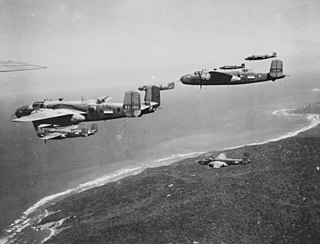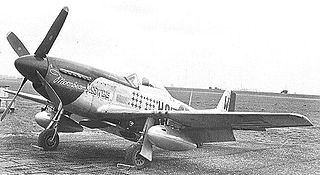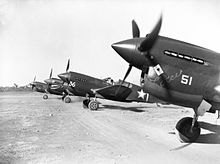
Richard "Dick" Ira Bong was a United States Army Air Forces major and Medal of Honor recipient in World War II. He was one of the most decorated American fighter pilots and the country's top flying ace in the war, credited with shooting down 40 Japanese aircraft, all with the Lockheed P-38 Lightning. He died in California while testing a Lockheed P-80 jet fighter shortly before the war ended. Bong was posthumously inducted into the National Aviation Hall of Fame in 1986 and has several commemorative monuments named in his honor around the world, including an airport, two bridges, a theater, a veterans historical center, a recreation area, a neighborhood terrace, and several avenues and streets, including the street leading to the National Museum of the United States Air Force in Dayton, Ohio.

The 4th Fighter Group was an American element of the United States Army Air Forces (USAAF) Eighth Air Force during World War II. The group was known as the Debden Eagles because it was created from the three Eagle Squadrons of the Royal Air Force: No. 71, No. 121 Squadron RAF, and No. 133 Squadron RAF. These squadrons became the 334th, 335th, and 336th Fighter Squadrons of the 4th Fighter Group based at RAF Debden. The group was the first fighter group to fly combat missions over German airspace, the first to escort bombers over Berlin, and the first selected to escort bombers on shuttle bombing runs landing in Russia. The group was credited with shooting down 1,016 German planes.

Clive Robertson Caldwell, was the leading Australian air ace of World War II. He is officially credited with shooting down 28.5 enemy aircraft in over 300 operational sorties, including an ace in a day. In addition to his official score, he has been ascribed six probables and 15 damaged. Caldwell flew Curtiss P-40 Tomahawks and Kittyhawks in the North African Campaign and Supermarine Spitfires in the South West Pacific Theatre. He was the highest-scoring P-40 pilot from any air force and the highest-scoring Allied pilot in North Africa. Caldwell also commanded a Royal Air Force (RAF) squadron and two Royal Australian Air Force (RAAF) wings. His military service ended in controversy, when he resigned in protest at the misuse of Australian First Tactical Air Force's fighter units and was later court martialed and convicted for trading liquor.
Sidney Sterling Woods was an American fighter ace of World War II with 7 victories in Europe and the Pacific theater.

George Earl Preddy Jr. was a United States Army Air Forces officer during World War II and an American ace credited with 26.83 enemy air-to-air kills, ranking him as the top P-51 Mustang ace of World War II and eighth on the list of highest scoring American aces.

No. 457 Squadron was a Royal Australian Air Force (RAAF) fighter squadron of World War II. Equipped with Supermarine Spitfire fighters, it was formed in England during June 1941 under Article XV of the Empire Air Training Scheme. The squadron was transferred to Australia in June 1942 and saw combat in the South West Pacific Area before being disbanded in November 1945.

The 8th Fighter Squadron is an active United States Air Force squadron, assigned to the 54th Fighter Group Air Education and Training Command, stationed at Holloman Air Force Base, New Mexico. It currently operates the General Dynamics F-16 Fighting Falcon aircraft, conducting initial training, transition and instructor upgrades training. The squadron have a proud lineage of aircraft and assignments. The origin of the 8th Fighter Squadron can be traced back to 1940, and since then, the squadron has served in several war and peace time assignments across the globe.

The 7th Fighter Squadron is an active United States Air Force unit, assigned to the 1st Operations Group. It is stationed at Langley Air Force Base, Virginia.

The North-Western Area Campaign was an air campaign fought between the Allied and Japanese air forces over northern Australia and the Netherlands East Indies (NEI) between 1942 and 1945. The campaign began with the Japanese bombing of Darwin on 19 February 1942 and continued until the end of the war.

Paul Bernard Wurtsmith was a United States Army Air Forces general during World War II.

Robert Wayne Aschenbrener was an American fighter pilot and flying ace of World War II.

The 49th Operations Group is the operational flying component of the United States Air Force 49th Wing. It is stationed at Holloman Air Force Base, New Mexico, and is a part of Air Combat Command (ACC).
No. 1 Wing was an Australian Flying Corps (AFC) and Royal Australian Air Force (RAAF) wing active during World War I and World War II. The wing was established on 1 September 1917 as the 1st Training Wing and commanded the AFC's pilot training squadrons in England until April 1919, when it was disbanded. It was reformed on 7 October 1942 as a fighter unit comprising two Australian and one British flying squadrons equipped with Supermarine Spitfire aircraft, and a mobile fighter sector headquarters. The wing provided air defence to Darwin and several other key Allied bases in northern Australia until the end of the war, and was again disbanded in October 1945.

The 487th Fighter Squadron is an inactive United States Air Force unit. It activated during World War II and was assigned to the 352nd Fighter Group of VIII Fighter Command. After training in the United States, it deployed to the European Theater of Operations, where it earned two Distinguished Unit Citations and a French Croix de Guerre with Palm for its combat actions. Following V-E Day, it returned to the United States and was inactivated at the port of embarkation, Camp Kilmer, New Jersey, on 9 November 1945.

The 352nd Fighter Group was a unit of the Eighth Air Force that was located in the European Theater of Operations during World War II. The unit served as bomber escort, counter-air patrols, and attacking ground targets. It initially flew P-47 Thunderbolt aircraft before converting to P-51 Mustang in April 1944. The group was located at RAF Bodney in England for the majority of its service and were nicknamed the Blue-nosed Bastards of Bodney due to the distinctive blue of the nose and upper cowl of the P-51 Mustangs of the group.

William Thomas Whisner Jr. was a career officer and pilot in the United States Air Force, retiring as a colonel with 30 years of military service. He was a fighter ace with Army Air Forces over Europe in World War II and a jet fighter ace with the Air Force in the Korean War.

James Philo Hagerstrom was a fighter ace of both the United States Army Air Forces (USAAF) in World War II and the U.S. Air Force (USAF) in the Korean War. With a career total of 14.5 victories, he is one of seven American pilots to have achieved ace status in two different wars.

North-Western Area Command was one of several geographically based commands raised by the Royal Australian Air Force (RAAF) during World War II. Its wartime sphere of operations included the Northern Territory, adjacent portions of Queensland and Western Australia, and the Dutch East Indies. The command was formed in January 1942, following the outbreak of the Pacific War, from the western part of Northern Area Command, which had covered all of northern Australia and Papua. Headquartered at Darwin, North-Western Area Command was initially responsible for air defence, aerial reconnaissance and protection of the sea lanes within its boundaries.

Gerald Richard Johnson was a World War II flying ace who flew for the United States Army Air Forces. Johnson commanded the 9th Fighter Squadron and 49th Fighter Group, and became the fourth ranking fighter ace in the Pacific during World War II. He ended his war career with 22 kills.
John Dave Landers was a colonel in the United States Army Air Forces. He flew with the 9th Fighter Squadron in the Pacific commanded the 357th Fighter Group and the 78th Fighter Group during World War II.






















